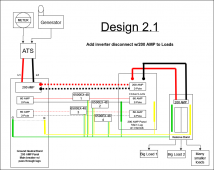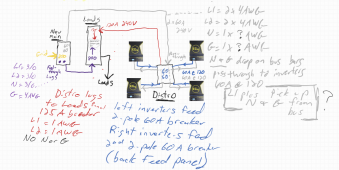Mudd216
New Member
- Joined
- Jul 12, 2022
- Messages
- 20
I started with Will's complete DIY 48V offgrid Solar Power System design and incorporated AC. At this point I was hoping folks could comment on the AC design to ensure I am on the right track. Next I would like to design for more flexibility and I am hoping folks could help point me in the right direction.
14KW solar, 30kWh EG4 battery kit, 4 6500EX-48
I intend to leverage solar/battery as much as possible and augment with grid/generator as needed. I have a back up propane generator with an ATS today and I want to leverage as much existing wiring as possible.


I would like to add a means to easily feed the loads panel from grid for maintenance or other situation . I am thinking maybe adding a 200 AMP breaker in the first panel and running it to a 200AMP breaker in the second panel and incorporating some sort of Generator Interlock Kit such that the second panel could be energized from either 200 AMP grid or 120AMP inverters but never both. I am not sure I can find panels/breakers/interlock kit to accomplish this. Maybe the right approach would be to incorporate a manual transfer switch in front of the loads panel and feeding the switch from the first panel and second panel (inverter feed).
I would also like to be able to manually switch some large appliances to grid while keeping everything else on the inverters. This would be a fail safe if my usage calculation are incorrect or change over time. Another scenario might be a house full of guests for the holidays and I know I will be consuming more than 26kW, instead of completely relying on grid I could just bypass large appliances.
Any feedback would be greatly appreciated.
14KW solar, 30kWh EG4 battery kit, 4 6500EX-48
I intend to leverage solar/battery as much as possible and augment with grid/generator as needed. I have a back up propane generator with an ATS today and I want to leverage as much existing wiring as possible.


I would like to add a means to easily feed the loads panel from grid for maintenance or other situation . I am thinking maybe adding a 200 AMP breaker in the first panel and running it to a 200AMP breaker in the second panel and incorporating some sort of Generator Interlock Kit such that the second panel could be energized from either 200 AMP grid or 120AMP inverters but never both. I am not sure I can find panels/breakers/interlock kit to accomplish this. Maybe the right approach would be to incorporate a manual transfer switch in front of the loads panel and feeding the switch from the first panel and second panel (inverter feed).
I would also like to be able to manually switch some large appliances to grid while keeping everything else on the inverters. This would be a fail safe if my usage calculation are incorrect or change over time. Another scenario might be a house full of guests for the holidays and I know I will be consuming more than 26kW, instead of completely relying on grid I could just bypass large appliances.
Any feedback would be greatly appreciated.





